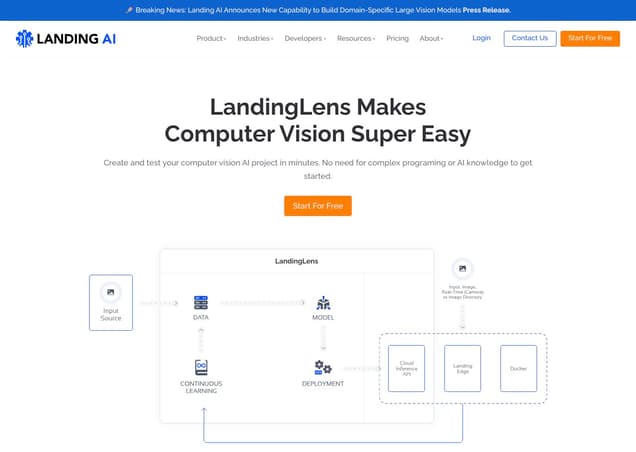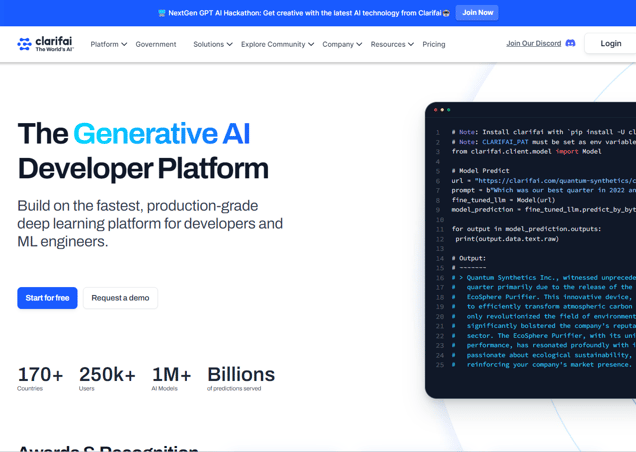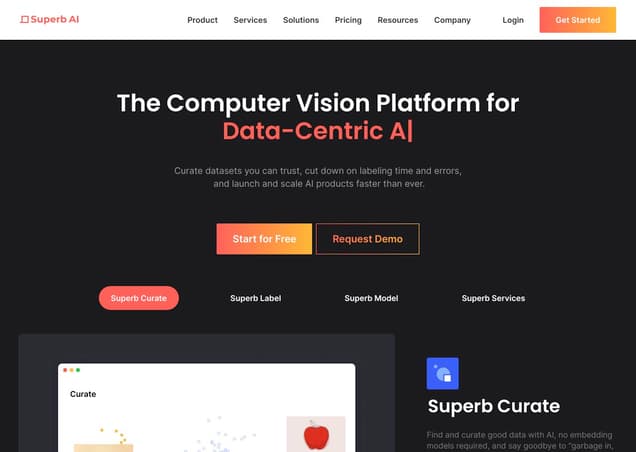OpenCV
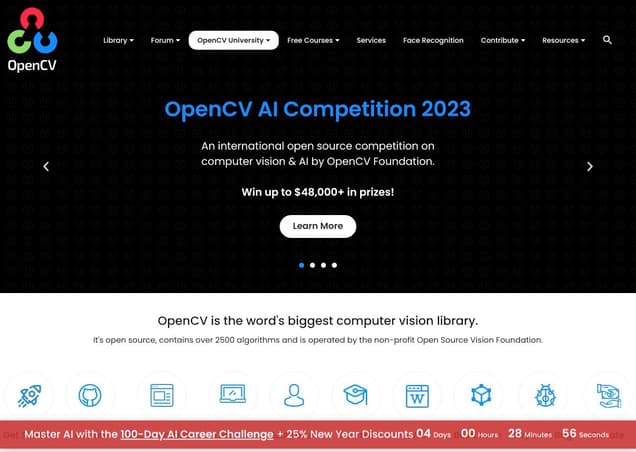
What is OpenCV ?
OpenCV (Open Source Computer Vision Library) is an open source computer vision and machine learning software library. It contains over 2500 algorithms and is operated by the non-profit Open Source Vision Foundation. Initially developed by Intel, OpenCV is designed for computational efficiency with a strong focus on real-time applications.
Features :
- Read and write images
- Capture and save videos
- Image processing such as filtering and transformation
- Feature detection
- Object detection
- Video analysis
Pricing :
- OpenCV is open source and released under the Apache 2 License, making it free for commercial use.
Estimated Visit Traffic :
1.17M /MonthUser Distribution :
United States - 9.06% | India - 8.41% | China - 7.37% | Turkey - 7.25% | Russia - 5.98%Tags :
AI Image RecognitionOpenCV AI Kit OAK-1 Review and Custom Model Inference
Hey there, visionaries! In today's exploration, we're diving deep into the OpenCV AI Kit OAK-1. This mighty module is taking the computer vision community by storm, and I'm here to give you the lowdown on whether it's a worthy addition to your AI arsenal, and how it fares when we task it with custom model inference.
1. Unboxing the OAK-1: A Glimpse into the Future of Vision
When the package arrived, anticipation was rife. The OAK-1 stands out with its petite frame—impressive when considering the tech it harbors. It features a high-quality 12MP camera and an Intel Movidius Myriad X vision processor, encapsulating advanced vision capabilities in a subtle 65 to 36mm body.,Comparing the OAK-1 to my smartphone, its diminutive stature belies its strength. Equipped with a myriad of vision accelerators, AI processing elements, and cool customizable features, the OAK-1 feels like holding a secret weapon for AI on the edge.,The engineering marvel doesn't end there. The OAK-1 boasts USB 3.1 connectivity and ISCs, enabling rapid data transfer and seamless interactions with other peripherals, making it a flexible and accessible tool for innovators and makers alike.
2. Setting Up and Diving In: Ready, Set, Infer!
Regarding software, simplicity wins. The OpenCV team delivers a user-friendly experience with an open-source API that plays well across different operating systems. Raspberry Pi enthusiasts will rejoice at the smooth support and integration offered.,With samples lighting up my Ubuntu system, I followed clear instructions from the official Luxonis website to get things fired up. The gist? Clone their GitHub repo, install dependencies, adjust module rules, and you're up and running—easy peasy!,Powering through the OpenVINO model zoo, the OAK-1 flexed its capabilities without breaking a sweat. Tapping into pre-trained models is as easy as running a single command, which is a delightful surprise for those new to the machine learning soiree.
3. The True Test: Training and Implementing Custom Models
But what about when the rubber meets the road? Moving beyond pre-trained models to custom object detection raised the stakes. Could the OAK-1 handle a bespoke kangaroo-counter? Spoiler: it sure could.,The process included training a neat little model and converting it for the OAK-1. Thanks to the fluidity offered by tools like 'accelerate' and comprehensive conversion guides, the journey from concept to edge deployment was a walk in the park.,Operationally, the OAK-1 supported a wide range of network architectures. It was impressive to see the module work with various neural network frameworks without hiccupping on compatibility, outdoing some of its competitors with its robustness and agility.
4. Community Buzz: Hurdles and High Hopes
Navigating community queries, it's apparent that locating resources like the pre-built Raspberry Pi image can be a hurdle for some. The vibrant back-and-forth with the community showcases the importance of clear, accessible documentation and support.,Enthusiasm shines as developers dream of implementing OAK-1 for diverse applications, from school face recognition systems to agricultural weed detection. The eagerness to integrate the toolkit into every project, whether it’s saving time on tedious counting or enhancing vehicle intelligence, is palpable.,Despite some reservations regarding the future of Intel-based solutions, the sentiment is largely optimistic. With some even eager for a Russian language version, it's clear the OAK-1 has tapped into a global zeitgeist hungry for edge-AI solutions.
5. Paving the Way for Customized Vision
Questions about the practicalities, like the weight of the units and where to order, are quickly resolved. The audience is engaged, ready to lay hands on the hardware and unleash their creativity.,Choices between the OAK-1 and its depth-sensing sibling OAK-D stir up discussions on the merits of additional cameras, particularly in complex scenarios like distinguishing weeds from grass—a testament to the nuanced decision-making that goes into deploying edge AI.,Endearing comments like the desire to integrate a kangaroo detector in a Tesla, and praise for the video's clarity and informativeness, underscore the blend of whimsy and earnest curiosity that drives the AI community forward.
6. OpenCV Video Summary
The OpenCV AI Kit OAK-1, an innovative computer vision hardware component, has garnered significant attention with its successful Kickstarter campaign. It promises to deliver powerful machine learning and computer vision capabilities at the edge, without the need for cloud computing. Today, we're examining its specs, assessing pre-trained model performance, and exploring how to implement custom models for specific inference tasks. Will this compact but mighty toolkit revolutionize the way we approach computer vision? Let's find out.
Other OpenCV Related Videos

OpenCV Artificial Intelligence Kit (OAK-1) - YouTubeJan 30, 2021

OpenCV AI Kit (OAK) Series 2 Cameras - #OpenCV Ep. 108 - YouTubeJul 11, 2023

Introducing OpenCV AI Competition 2023 - YouTubeJul 10, 2023

OpenCV AI Kit _ OAK-D - YouTubeJan 24, 2021

How to Deploy a Custom Model to your OpenCV AI Kit (OAK) - YouTubeJul 25, 2021

OpenCV AI Kit - Open Source Spatial AI - Now Available on Kickstarter - YouTubeJul 28, 2020

Creating Mixed Reality Experiences with OpenCV AI Kit - Weekly Episode 29 - 10/14/21Oct 20, 2021

OpenCV Python Course - Learn Computer Vision and AI - YouTubeJun 7, 2021

Welcome to OpenCV University: Your Compass in the AI Universe - YouTubeNov 2, 2023
User Reviews On Twitter
 Kat Scott 🐀Computer vision, robotics, software, hardware and stuff. Advocate @OpenRoboticsOrg / @rosorg. Board @ohsummit. 🐘 [email protected] & bsky👀 The OpenCV crew may have a good idea, they're publicly announcing companies that make millions off the open source library but do not financially support its continued development.
Kat Scott 🐀Computer vision, robotics, software, hardware and stuff. Advocate @OpenRoboticsOrg / @rosorg. Board @ohsummit. 🐘 [email protected] & bsky👀 The OpenCV crew may have a good idea, they're publicly announcing companies that make millions off the open source library but do not financially support its continued development.
Successful companies need to support the FOSS projects they rely on.
opencv.org/blog/who-uses-opencv-part-1-snap-inc-meta/ Sanjay DuttaComputer Vision | ML Researcher | Deep Learning | Coder | Python developer | 🚩📝#FOLLOW for #Learning_Resources, Latest AI News, Tools and Updates ⏬🚩Why You Should Absolutely Learn Pytorch?
Sanjay DuttaComputer Vision | ML Researcher | Deep Learning | Coder | Python developer | 🚩📝#FOLLOW for #Learning_Resources, Latest AI News, Tools and Updates ⏬🚩Why You Should Absolutely Learn Pytorch?
#PyTorch #MachineLearning #DeepLearning #DataScience #ArtificialIntelligence #Programming #Python #SkillsDevelopment #TechEducation #AIResearch #FutureTechnology
Read more: opencv.org/blog/2023/09/13/learn-pytorch-in-2023/ YangOpenCV's Platinum Membership - OpenCV opencv.org/opencv-platinum-membership/
YangOpenCV's Platinum Membership - OpenCV opencv.org/opencv-platinum-membership/ OpenCV UniversityTake your first steps to Mastery in AI with our Free Bootcamp👇Ready to conquer the world of Computer Vision? 🚀
OpenCV UniversityTake your first steps to Mastery in AI with our Free Bootcamp👇Ready to conquer the world of Computer Vision? 🚀
opencv.org/blog/computer-vision-engineer-roadmap/
Our latest guide covers all you need, from image processing to deep learning. Perfect for tech enthusiasts!
#ComputerVision #deeplearning #ai #ArtificialIntelligence #machinelearning #opencv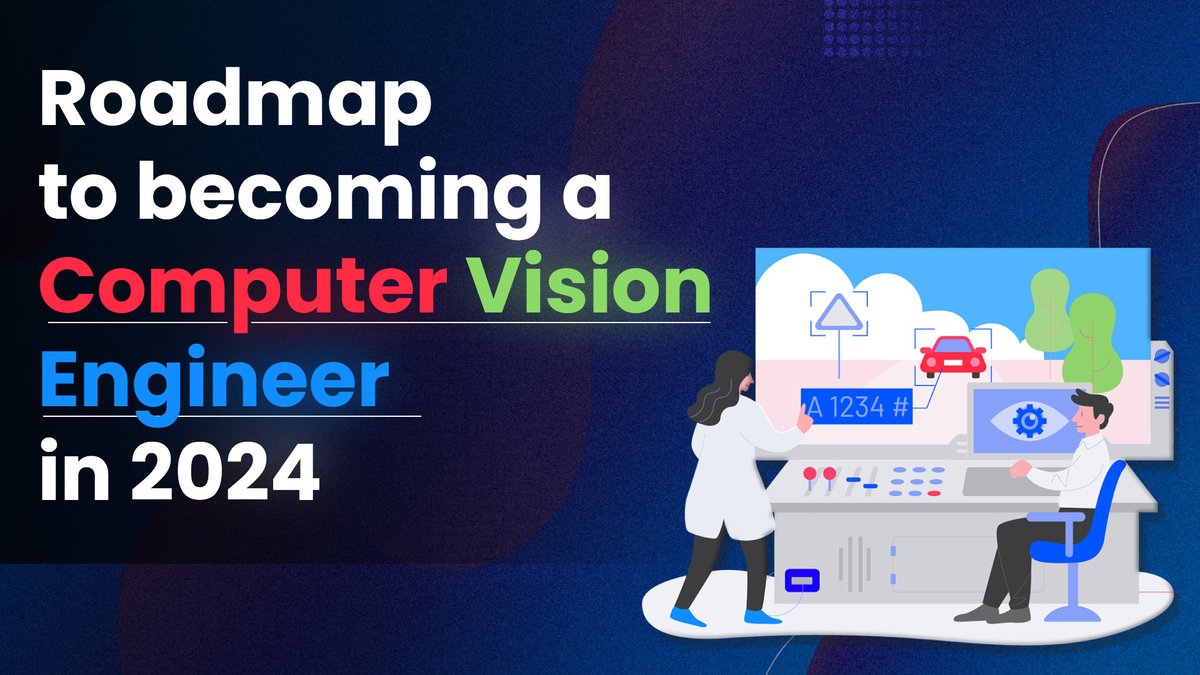
 OpenCV UniversityTake your first steps to Mastery in AI with our Free Bootcamp👇Exploring Europe's best in computer vision research. Discover what sets universities like TUM, Imperial College, UCL, and EPFL apart in this cutting-edge field. A must-read for tech enthusiasts and future visionaries!
OpenCV UniversityTake your first steps to Mastery in AI with our Free Bootcamp👇Exploring Europe's best in computer vision research. Discover what sets universities like TUM, Imperial College, UCL, and EPFL apart in this cutting-edge field. A must-read for tech enthusiasts and future visionaries!
opencv.org/blog/top-research-universities-in-europe/
#ComputerVision #TechEducation…
 Python_alertプログラム言語Pythonの記事をつぶやきます。How to call a C++ function containing OpenCV's CUDA from a python DLL - OpenCV Forum dlvr.it/Sr1PSJ
Python_alertプログラム言語Pythonの記事をつぶやきます。How to call a C++ function containing OpenCV's CUDA from a python DLL - OpenCV Forum dlvr.it/Sr1PSJ ماجستير ودكتوراهإعداد #البرمجيات_التعليمية- #عروض_تقديمية#تحليل_إحصائي #استشارات_بحثية - #التدقيق_اللغوي #مقترحات_بحثية #المساعدة_في_النشر_العلمي [email protected]أدوات الذكاء الاصطناعي الأكثر استخداما بين الباحثين:
ماجستير ودكتوراهإعداد #البرمجيات_التعليمية- #عروض_تقديمية#تحليل_إحصائي #استشارات_بحثية - #التدقيق_اللغوي #مقترحات_بحثية #المساعدة_في_النشر_العلمي [email protected]أدوات الذكاء الاصطناعي الأكثر استخداما بين الباحثين:
يقوم بتوليد المحتوى وتفسير النتائج
keras.io/
تحليل البانات بالذكاء الاصطناعي
scikit-learn.org/
أدوات إنتاج الصور والرسوم
opencv.org/
تعطيه النص يقوم بتفسيره وتحليليه
www.nltk.org/
 The 4th Wave AIThe 4th wave will be in Artificial Intelligence, Quantum Computing, Nanotechnology, Biotechnology, and Robotics. We focus on the latest NEWS & REVIEWS.OpenCV University - Learn Computer Vision, Deep Learning, and AI | Official OpenCV Courses - goo.gl/alerts/hBk8jf #GoogleAlerts
The 4th Wave AIThe 4th wave will be in Artificial Intelligence, Quantum Computing, Nanotechnology, Biotechnology, and Robotics. We focus on the latest NEWS & REVIEWS.OpenCV University - Learn Computer Vision, Deep Learning, and AI | Official OpenCV Courses - goo.gl/alerts/hBk8jf #GoogleAlerts Yur1🚀Welcome to my professional Twitter profile! Here, I will keep you up-to-date on the latest trends and advancements in the world of IT, AI, and cryptocurrencies5. opencv.org/ - An open-source computer vision library that provides tools for image and video processing.
Yur1🚀Welcome to my professional Twitter profile! Here, I will keep you up-to-date on the latest trends and advancements in the world of IT, AI, and cryptocurrencies5. opencv.org/ - An open-source computer vision library that provides tools for image and video processing. Machine Learning RantsImage Processing and Pattern Recognition. Not that AgI rubbish! Sometimes hardware and general computer programming.@DJSnM @BlueAngels The magic happens inside Laplacian. The text in OpenCV's documentation: "we deduce that ... can be used to detect edges." is relevant. Alongside with its graph. [ attached, taken from here: docs.opencv.org/3.4/d5/db5/tutorial_laplace_operator.html ]
Machine Learning RantsImage Processing and Pattern Recognition. Not that AgI rubbish! Sometimes hardware and general computer programming.@DJSnM @BlueAngels The magic happens inside Laplacian. The text in OpenCV's documentation: "we deduce that ... can be used to detect edges." is relevant. Alongside with its graph. [ attached, taken from here: docs.opencv.org/3.4/d5/db5/tutorial_laplace_operator.html ]
So when the image is sharp, one can expect many strong edges…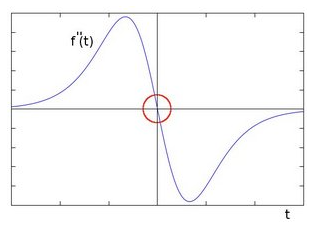
What users think about OpenCV - from Twitter
- OpenCV publicly recognizes companies benefitting from its open source library without financial contribution, emphasizing the need for commercial benefactors to support open source projects.
- OpenCV provides learning resources on its platform, including guides on computer vision, image processing, deep learning, and AI, catering to tech enthusiasts and developers.
- The platform advocates for learning PyTorch, linking it to skill development in fields like machine learning, data science, and AI research.
- OpenCV has a Platinum Membership program for users with advanced needs and to support the sustainability of the project.
- OpenCV.org features insights into leading European institutions conducting research in computer vision, marking importance for tech education and innovation.
- The OpenCV forum facilitates discussions and solutions, for instance, how to call C++ functions containing OpenCV's CUDA through a Python DLL.
- OpenCV is highlighted among the most utilized AI tools by researchers for tasks such as content generation, image production, and analytical processes.
- Official OpenCV courses in computer vision, deep learning, and AI are available through OpenCV University.
- OpenCV.org is recognized as a valuable open-source computer vision library providing various tools for image and video processing.
- Documentation and tutorials, such as those explaining the detection of edges in images using Laplacian functions, underline OpenCV's utility in technical applications.
OpenCV Pros and Cons
Pros :
- Highly optimized for real-time applications
- Supports multiple programming languages and platforms
- Extensive set of algorithms for computer vision and machine learning
Cons :
- Python interface may be slower compared to C/C++
- Steep learning curve for beginners
- Broad scope may be overwhelming for specific use-cases
OpenCV FQA
1. How can I get support for OpenCV?
Support is available through documentation, tutorials, and a Q&A forum. For debugging, use the documentation and tutorials. For specific issues, use the OpenCV Answers forum or GitHub issue tracker.
2. What are the primary application areas of OpenCV?
OpenCV is used in various fields like robotics, medicine, industrial automation, security, and transportation. It supports applications such as facial recognition, object detection, and video analysis.
3. What programming languages does OpenCV support?
OpenCV supports C++, Python, Java, and has bindings for Python, Java, MATLAB/Octave, and JavaScript.
OpenCV Use Cases
- Robotics: navigation, obstacle avoidance, human-robot interaction
- Medicine: classification and detection of tumors, 3D organ reconstruction
- Industrial Automation: defect detection, barcode reading
- Security: surveillance, biometrics
- Transportation: driver vigilance, autonomous vehicles
Similartool.ai Spotlight
Display Your Achievement: Get Our Custom-Made Badge to Highlight Your Success on Your Website and Attract MoreVisitors to Your Solution.


